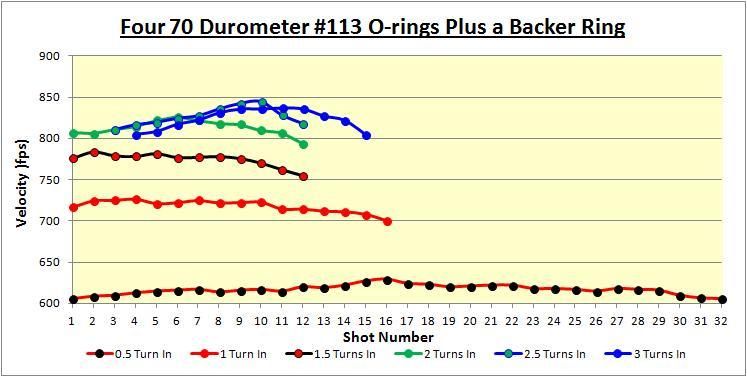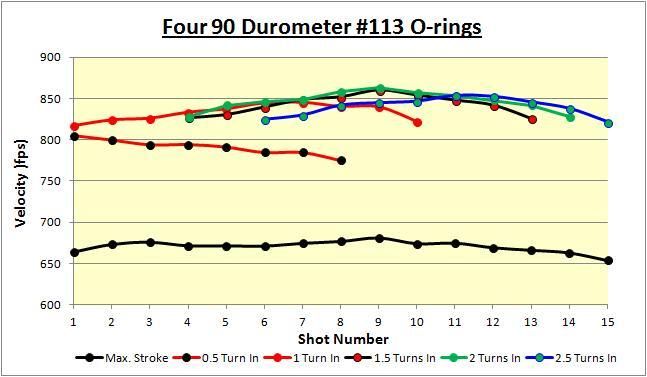After having a delay due to a burst disc failing and draining my SCUBA tank, and subsequently having to refill it (a long process with a ShoeBox).... I got back to doing more testing today.... I installed a stack of four 90 Durometer O-rings, this time without the 0.055" thick backer ring.... I figured that since the O-rings deflect a lot less than the 70D, I would have sufficient adjustment range between Max. CCW and 4 turns in (the settings I used before) to see what we need to see.... Well, at max. CCW (minimum lift) I got just about what I expected, but the rest of the results leave me totally confused.... Here is what happened....
I used the same colours for all the stroke settings as on the other two graphs.... The vertical scale is the same, but it is shifted down 50 fps in velocity to include all the curves.... The graph is even the same length as the original (no O-ring) graph.... The black "max. stroke" curve starts at nearly maximum velocity, indicating that the hammer spring preload is too high.... The efficiency is 1.23 FPE/CI, in between what I got unbuffered and with the 70D buffer.... I think that if the entire curve was included, it would be a pretty usable string, and the data fits well with what I got using the 70D buffer.... Now for the bad news....
First of all, the other four curves show the OPPOSITE trend for the velocity to what you would expect in a bstaley gun.... As you turn the striker in CW, the valve lift increases, and the velocity is suppose to increase with it.... That was plainly the case with the 70D buffer.... With the 90D O-rings, however, the highest velocity occurred at only 1 turn in, and the velocity DROPPED as I turned the striker in CW, with the lowest velocity (not counting the black line) occurring with the striker in 4 turns.... Three of the curves, on the face of it, look pretty decent in length, 14-15 shots.... The problem is, that the efficiency of all four of these curves was WORSE that the unbuffered gun.... It ran from 0.93 to 1.08 FPE/CI, improving as the velocity dropped.... The velocity with the buffer ran about 30-40 fps lower than the unbuffered gun, and the efficiency was poor as well, so this setup is pretty much a bust, IMO.... The big question is WHY ???
A day or two ago, I had a request to measure the valve lift with a buffer in place.... While I had the stack of four 90D O-rings in the gun, I added the Lift Indicator Rod, set the striker to Max. CCW, readjusted the preload to just shy of cioil bind, and measured the lift at three pressures, 2000, 1500, and 1000 psi.... I then pulled the gun apart, wound the striker in four turns CW, and repeated the measurements.... Here are the results....
A word of caution here.... I was having trouble with the O-ring cocking on the rod (ie not staying perpendicular to it), so it was hard to measure.... I would give a tolerance of about 0.005" plus/minus to the above numbers, but the TREND is pretty clear.... There is VERY little lift occuring when the striker is Max CCW, but it is still about twice as much at 1000 psi as it is at 2000.... and it only takes about 1/64" of lift to produce 640 fps (13 FPE) at 2000 psi.... AMAZING !!! ....
I'll be looking forward to seeing your analysis of these rather confusing results.... So far, it would appear that with a Disco, the 70D O-rings are far superior.... So where do we go from here?....
Bob








 Reply With Quote
Reply With Quote








